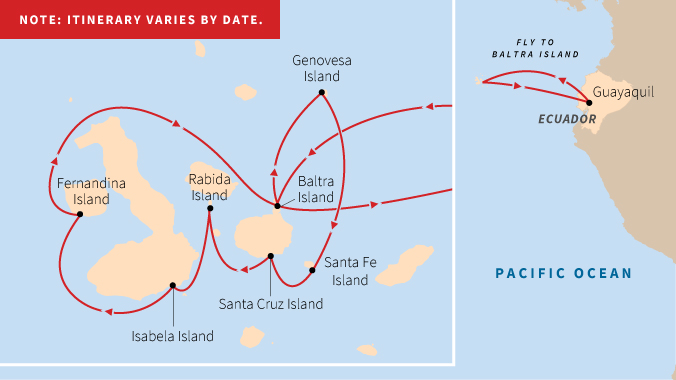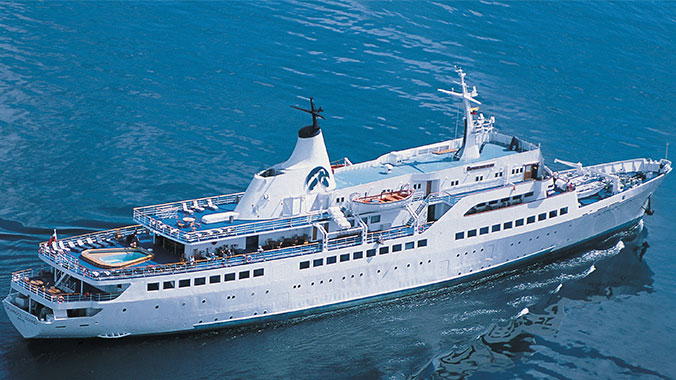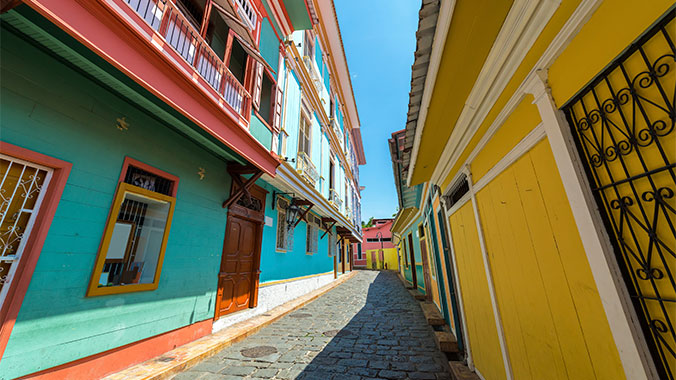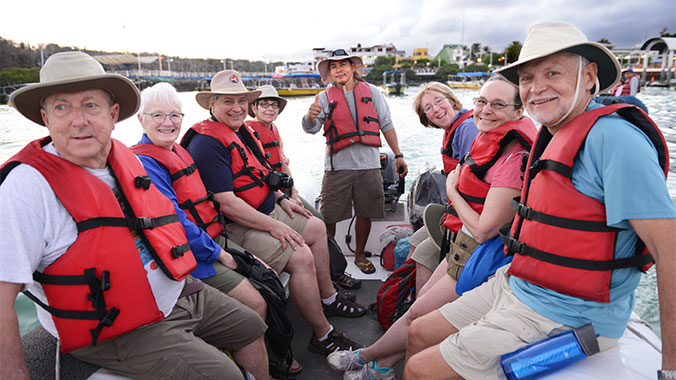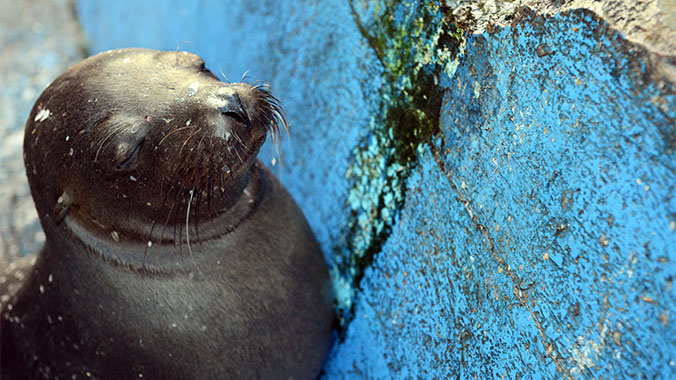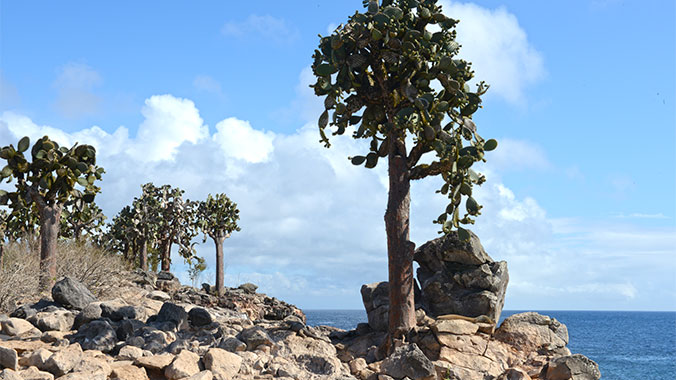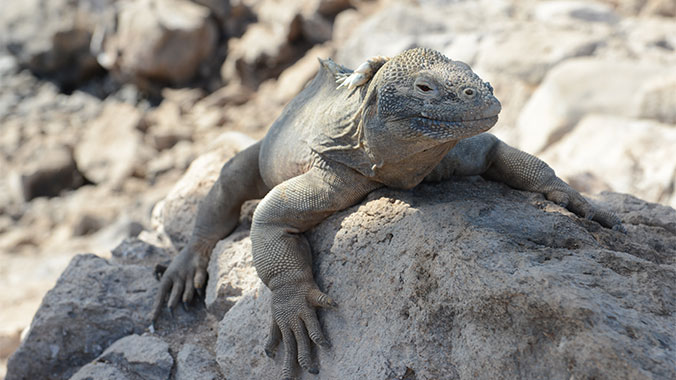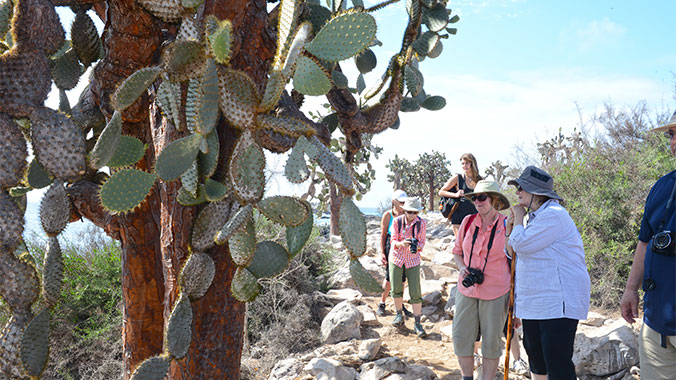Galápagos Islands, Ecuador
Galápagos Islands: Natural Treasures & Amazing Wonders
Program No. 23384RJ
Discover the Galápagos Islands at a leisurely pace as expert naturalists immerse you in the ever-evolving story of one of the world’s iconic ecosystems.
Itinerary
While we make every effort to ensure the accuracy of our published materials, programs are typically advertised more than a year prior to their start date.
Read More.
All itineraries and excursions are subject to change. Weather and water conditions may affect the progress of the ship, and we may miss ports if it is not safe to dock. The operators reserve the right to change the content and duration of excursions without prior notice and so the cruise itinerary should always be regarded as provisional. Whenever possible, Road Scholar’s published daily schedule will indicate port arrival and departure times. Prior to departure, if there is a major change, we will make every effort to alert you. For less significant changes, we will update you during orientation. Thank you for your understanding.
Duration
11 days
10 nights
What's Included
27 meals (
10B, 8L, 9D
)
2 expert-led lectures
15 expert-led field trips
2 flights during the program
An experienced Group Leader
10 nights of accommodations
Taxes and customary gratuity
Road Scholar Assurance Plan
Day
1
In Transit to Program, Arrive to Guayaquil
Location:
Guayaquil
Stay:
Hotel Oro Verde
Activity Note
Hotel check-in from 3:00 p.m. Remember to bring your nametag (sent previously).
Evening:
At leisure. Check in at the hotel, settle in, and get a good night’s rest for in preparation for the day ahead.
Day
2
Orientation, Guayaquil's Malecon
Location:
Guayaquil
Meals:
B,L,D
Stay:
Hotel Oro Verde
Activity Note
Getting on/off a bus; driving about 50 miles, approximately 2 hours riding time. Walking up to 2 miles, approximately 2.5 hours; slow paced walking on paved surfaces, some steps, intermittent periods of standing. Many opportunities for sitting/resting along the way.
Breakfast:
At the hotel.
Morning:
Orientation: 8:30 a.m. The Group Leader will greet everyone and lead introductions. We’ll review the up-to-date program schedule, discuss roles/responsibilities, logistics, safety guidelines, emergency procedures, and answer questions. We will learn from the Group Leader as well as an expert naturalist who will give lectures and lead field trips. Program-related travel and transfers will be via private bus unless noted otherwise. During the cruise, getting to/from shore for land field trips will require getting in/out of tenders (also known as pangas). Some wet and dry landings. Periods in the schedule designated as “Free time” and “At leisure” offer opportunities to do what you like and make your experience even more meaningful and memorable according to your personal preferences. The Group Leader will be happy to offer suggestions. Next, we'll visit a typical coastal hacienda that grows bananas and cocoa. We’ll learn from a farm representative about the sowing and harvesting process and what is needed to prepare the goods for export. Banana and cacao are some of the most exported products in the nation and important revenue sources for Ecuador.
Lunch:
At a local restaurant.
Afternoon:
We’ll then ride by bus to Guayaquil’s waterfront area in preparation for a walking exploration of the colorful neighborhood of Las Peñas and the bustling Malecón (river walk). Our Group Leader will reveal interesting aspects about Guayaquil's history and its miraculous transformation from a seedy port to a vibrant city centered on an attractive 2-mile riverfront walkway. Las Peñas runs the length of Numa Pompilio Llona (its only street) and its architecture exemplifies Ecuador’s coastal colonial style.
Dinner:
At the hotel.
Evening:
At leisure. Prepare for early morning check-out and our flight to the Galápagos tomorrow. This is a Road Scholar Adventures Afloat program. In addition to lectures and field trips exclusively for our Road Scholar group, you are invited to take advantage of activities and events aboard ship that are separate from the Road Scholar program. The time available in each port is set by the cruise line. Whenever possible, the Road Scholar daily schedule indicates port arrival and departure times (subject to change by the cruise line). This may mean that free time in port is limited. Regardless of the time in port, Road Scholar delivers a robust educational program. All routes, field trips, and excursions are subject to change as weather and sea conditions could affect the progress of the ship, making it run late and/or miss ports if it is not safe to dock. Because of this, the cruise itinerary should always be regarded as provisional. The operators reserve the right to change the content of field trips and excursions without prior notice. In the event of changes, we will alert you as quickly as possible.
Day
3
Fly to Baltra, Embarkation, N. Seymour Is.
Location:
Galapagos Islands
Meals:
B,L,D
Stay:
MV Galapagos Legend
Activity Note
Getting on/off a bus, airplane, and pangas (boat tenders). Flight to Galápagos is approximately 2 hours; checked luggage limit is 50 pounds; extra luggage can be stored at the hotel in Guayaquil. Schedule is representative; actual cruise itinerary and islands visited are determined by the National Park. North Seymour Island: dry landing, moderate to difficult trail conditions due to uneven terrain; about 1.5 miles walking.
Breakfast:
Early at the hotel.
Morning:
After check-out, we’ll board the bus and ride to the airport to check in for our flight to the Galápagos Islands. Our Group Leader will assist with check-in procedures and then we'll proceed through security and get ready to embark on our flight. Upon arrival to the Galápagos Islands’ Seymour Airport (GPS) on Baltra Island, we'll deplane and walk across the tarmac to the airport building and complete immigration procedures. After collecting our luggage, we will meet our naturalist Galápagos Group Leader and board a bus that will drive us to the pier, followed by a short ride to the ship on a panga, or tender. After attending a welcome orientation and a safety drill, the ship will set sail to the first visitor site on our cruise. Throughout the program, our Group Leader and a park naturalist will accompany us on field trips. The Galápagos National Park regulations require one certified park naturalist for a group of up to 16 people; if the group exceeds 16, we will have two naturalists. This program will follow the routes and allowed activities at specific visitor sites as established by the park. Everything will be carried out at a slower pace. Before each field trip/walk, our leaders will outline what physical parameters to expect so that you can evaluate your needs and prepare accordingly. You may always choose to remain on the ship enjoying onboard amenities if you wish to skip an activity.
Lunch:
Aboard ship.
Afternoon:
After a dry landing, our naturalist will lead us on an exploratory walk on local trails. North Seymour Island is conveniently located next to Baltra Island. The island has a major nesting colony of Blue-footed Boobies and Magnificent Frigatebirds. During April-May the Blue-footed Boobies can be spotted performing their comical mating dance. Blue-footed Boobies oftentimes nest very near the trails, giving visitors the opportunity to get a closer view during the walks. From August-November sea lions are giving birth and it is possible to view pups of all sizes. Just remember to stay at a safe distance as females tend to be very protective of their young. A walk near known iguana nesting sites offers a good opportunity to view marine iguanas and land iguanas. Besides boasting abundant fauna, North Seymour Island is dotted with the endemic Palo Santo tree (Bursera graveolens). Before returning to the ship, we will have the opportunity to swim and snorkel.
Dinner:
Aboard ship, following a welcome cocktail with the crew.
Evening:
With our Group Leader, we’ll go over the activities for the following day. The remainder of the evening will be at leisure.
Day
4
Bartolome Island, Santiago Island, Sullivan Bay,
Location:
Galapagos Islands
Meals:
B,L,D
Stay:
MV Galapagos Legend
Activity Note
Bartolome Island: dry and wet landings, moderate to difficult trail conditions due to a long walkway of 375 wooden steps rising 374 ft. to the lookout point. Sullivan Bay: wet landing and moderate difficulty due to rocky, volcanic terrain. The looping visitor trail is approximately 1 mile in length. Wear comfortable tennis shoes with good ankle support.
Breakfast:
Aboard ship.
Morning:
After a dry landing, we will accompany our naturalist Group Leader on a walk up Escalera Hill on Bartolomé Island. On Bartolomé Island we will be able to view volcanic formations such as lava bombs, spatter, and cinder cones. From the summit it is possible to take in scenic vistas of surrounding islands as well as Pinnacle Rock's eroded tuff cone. On the way to the summit we will be on the lookout for for colonies of marine iguanas, lava lizards, tiquilla and various cacti. Coastal areas of Bartolomé are often frequented by Galápagos penguins. During part of the year, they leave the island in search of cooler waters found around Fernandina and Isabela. Once the penguins return to Bartolome in August, they waste no time in getting ready for romance. By September they can be observed going through courtship rituals. Before returning to the ship, we’ll have the opportunity to swim and/or snorkel.
Lunch:
Aboard ship.
Afternoon:
We’ll make a wet landing on Santiago Island (a.k.a. San Salvador), then accompany our naturalist leader on rocky trails in search of volcanic formations and resident wildlife. A volcanic eruption that took place in the early 1900’s formed huge lava flows in the area that is now Sullivan Bay. As the lava cooled off, it solidified into a black sheet of interesting shapes and textures that made their way to the sea. The rope-like lava seen on this island is called pahoehoe lava. Other interesting formations include lava bubbles and tree shapes; ghosts of Santiago’s past. Few plant species have been able to root in this harsh environment. Although the volcanic formations on Santiago have the obvious spotlight, keep an eye out for American Oystercatchers nesting along the coast (July) and Galápagos Hawks performing their acrobatic courtship rituals (August). Before returning to the ship, we'll have the opportunity to snorkel.
Dinner:
Aboard ship.
Evening:
Enjoy an expert presentation by our naturalist Group Leader, followed by an orientation to the next day's activities. (Please note that the day/time of lectures is subject to change).v
Day
5
San Cristobal Island, Punta Pitt, Cerro Brujo
Location:
Galapagos Islands
Meals:
B,L,D
Stay:
MV Galapagos Legend
Activity Note
Punta Pitt: wet landing on a beach frequented by sea lions (young males and retired adults). Keep your distance to avoid disturbing them. Hike lasts approximately 2.5 hours; challenging trail requires climbing a steep ravine on slippery terrain. Cerro Brujo: wet landing and easy walking on sandy trails; snorkeling from beach.
Breakfast:
Aboard ship.
Morning:
We'll board a panga and tender to San Cristobal Island in preparation for our wet landing at the northeast end of the island. Next, we’ll join our naturalist on a challenging hike in search of local flora and fauna at Punta Pitt. This is the only site in the islands where visitors can watch all three species of boobies and two species of frigates nesting in the same area. The abundant supply of food in the area makes it unnecessary for the birds to compete, leading to a peaceful coexistence among the species. Blue-footed Boobies generally nest in the interior areas of the island, while Red-footed boobies nest on bushes, and Masked Boobies nest along the cliffs. The wind-carved landscape of this seemingly barren island is quite breathtaking. A closer look reveals a surprising array of plant life that, against all odds, continues to thrive here. We’ll also look for Palo Santo trees, small cacti, saltbush, and red Vesuvius. Opportunity to snorkel, swim, and kayak before returning to the ship.
Lunch:
Aboard ship.
Afternoon:
Well make a wet landing at Cerro Brujo to enjoy a nature walk on a white sand beach that is often frequented by lively sea lions. Before returning to the ship we will have the opportunity to swim, snorkel, and/or kayak from the beach.
Dinner:
Aboard ship.
Evening:
With our Group Leader, we’ll go over the activities for the following day. The remainder of the evening will be at leisure.
Day
6
San Cristobal, Cerro Colorado, Interpretation Ctr, Tijeretas
Location:
Galapagos Islands
Meals:
B,L,D
Stay:
MV Galapagos Legend
Activity Note
Cerro Colorado: dry landing, easy walking on mostly flat unpaved and paved paths. Interpretation Ctr: dry landing; standing and walking on flat, paved terrain and some stairs. Tijeretas Hill: hiking about 1 mile, each way, on rocky terrain with inclines.
Breakfast:
Aboard ship.
Morning:
After a dry landing on San Cristobal Island, we'll board a bus to the Cerro Colorado Tortoise Reserve (a.k.a. La Galapaguera) to learn about its efforts to increase the island's native tortoise population. During our visit, we'll be able to view San Cristobal tortoises in all stages of development, wandering in semi-natural habitats.
Lunch:
Aboard ship.
Afternoon:
Dry landing at Puerto Baquerizo Moreno, San Cristobal Island. Our Galápagos naturalist will escort us through the Interpretation Center and its exhibits. Opened in 1998, the center features expositions on natural history, human history and conservation efforts in the islands. The Museum of Natural History explains the series of natural circumstances, such as ecological and environmental events, that formed the islands. The Human History exhibit narrates the most significant events regarding the discovery and colonization of the islands. We will then hike to Frigatebird Hill (also known as Tijeretas Hill) to enjoy scenic views of San Cristóbal’s western coastline. Since this is a known nesting site for Great Frigatebirds and Magnificent Frigatebirds, we hope to spot a few of them showing off their acrobatic flying skills. We’ll hike back the way we came and return to the ship.
Dinner:
Aboard ship.
Evening:
We will enjoy an expert presentation by our naturalist Group Leader, followed by an orientation to the next day’s activities. (Please note that the day/time of lectures is subject to change.)
Day
7
Española Island, Gardner Bay, Suarez Point
Location:
Galapagos Islands
Meals:
B,L,D
Stay:
MV Galapagos Legend
Activity Note
Gardner Bay: wet landing and easy, sandy trail conditions. Punta Suarez: dry landing and difficult trail conditions due to rocky, uneven terrain; hiking up to 2 miles, approximately 2.5 hours.
Breakfast:
Aboard ship.
Morning:
Following a panga ride to Española, we will make a wet landing at the white sand beach in Gardner Bay. A short walk and swimming/snorkeling activities off the beach will give us the opportunity to relax in one of the islands' most beautiful locations. Gardner Bay’s white beach is usually dotted with sunbathing sea lions. The soft sand and clear waters make this a perfect location for snorkeling and swimming. In January, green sea turtles steal ashore under cover of night to dig pits and lay eggs before making their way back to sea. Eggs hatch from April to May. We'll navigate around Osborn and Gardner Islets on our way back to the ship.
Lunch:
Aboard ship.
Afternoon:
We’ll make a dry landing at Punta Suarez in preparation for an estimated 2.5-hour hike. Our walking exploration will take us over loose boulders and challenging rocky ground as we make our way to view nesting boobies and the famous blowhole. Punta Suarez is home to the Galápagos Hawk and the red form of the marine iguana. In January, the iguanas change color, adopting bright hues that are attractive to potential mates. Visitors have a good chance of seeing Blue-footed Booby chicks around October. Española is also the breeding site of most of the archipelago's Waved Albatrosses, so be on the lookout for these large and graceful flyers! Albatrosses display courtship behavior in April, nest and lay eggs in May, and by December the young fledge and leave for a few months before returning in March. After our explorations, we will return to the ship in time to freshen up for dinner.
Dinner:
Aboard ship.
Evening:
Orientation of next day's activities.
Day
8
Floreana, Post Office Bay & Cormorant Point, Devil’s Crown
Location:
Galapagos Islands
Meals:
B,L,D
Stay:
MV Galapagos Legend
Activity Note
Post Office Bay: wet landing and easy/flat trail conditions. Punta Cormorant: wet landing and easy trail conditions. Devil's Crown: due to strong currents, this site is only recommended for very strong swimmers.
Breakfast:
Aboard ship.
Morning:
Our half-mile walk at Post Office Bay will begin with a wet landing on the sandy beach and then a visit to the Post Office Barrel. The famous Post Office Bay can be found on the northern side of Floreana Island. This is the site where whalers used to “mail” their correspondence. A barrel was used as a makeshift postbox which held letters from sailors across the globe. If a passing ship happened to be heading where the mail was addressed to, the captain would collect and deliver it. Although the original barrel is no longer in use, the system still works as visitors continue to collect and drop off their letters and postcards. Before returning to the ship, we’ll have the opportunity to swim and/or snorkel.
Lunch:
Aboard ship.
Afternoon:
We’ll navigate by panga to Floreana and make a wet landing on the green beach at Punta Cormorant. During our walking explorations we hope to observe shorebirds and flamingos at the local lagoon and spot endemic plants such as Scalesia vellosa andLecocarpus pinaffitidus. We will most likely have the chance to spot sea lions lounging lazily on the beach. The beach’s unusual color is a result of the olivine crystals present in the sand. From here, a trail leads us to a lagoon where flamingos can be found wading with other birds such as oystercatchers, and Black-necked Stilt. A white sandy beach near the lagoon is good for swimming and is a known nesting site for green sea turtles. Around January, pregnant females come ashore at night to dig nests and lay eggs (between 75-100 eggs per nest) before returning to sea. The eggs begin hatching in April and May. Depending on weather/sea conditions, we’ll either navigate to Champion Islet or to Devil’s Crown to enjoy swimming and snorkeling. Devil’s Crown is a shallow sunken crater that makes for one of the best snorkeling sites in the islands. The largely submerged volcano has clear blue waters and a variety of colorful fish. Sea lions are sometimes seen frolicking in the waters and seabirds nest in the crevices. This site is only suggested for strong swimmers as the currents can be very strong.
Dinner:
Aboard ship.
Evening:
Orientation to the next day's activities.
Day
9
Santa Cruz Island, Cerro Dragon, Punta Bowditch
Location:
Galapagos Islands
Meals:
B,L,D
Stay:
MV Galapagos Legend
Activity Note
Cerro Dragon: dry landing, easy to moderate trail conditions due to rocky, uneven terrain. Punta Bowditch: wet landing, slow-paced walking on mostly flat, unpaved trails, swimming and snorkeling.
Breakfast:
Aboard ship.
Morning:
Our field trip to Cerro Dragon will begin with a panga ride and dry landing on Santa Cruz. An uphill trail will lead us to a lookout point on Cerro Dragon (Dragon Hill). The hill earned its name due to a colony of land iguanas that inhabited the site in the 1970s. Flamingos and shorebirds seasonally visit the lagoons in search of shrimp, appearing in larger numbers during the dryer season when the crustaceans are more plentiful. The rocky beach provides good snorkeling opportunities when the tide is high.
Lunch:
Aboard ship.
Afternoon:
After a wet landing at Punta Bowditch, we'll begin our walking exploration beside salt pools and dried white corals. We’ll enjoy snorkeling and swimming from the beach, where we will have the chance to see different species of parrotfish, Mexican hogfish, and giant schools of black-striped salema. We’ll then return to the ship.
Dinner:
Aboard ship.
Evening:
Orientation of next day’s activities, followed by time at leisure. Prepare for final disembarkation in the morning.
Day
10
Highland Tortoise Reserve, Fly to Guayaquil, Farewell Dinner
Location:
Guayaquil
Meals:
B,D
Stay:
Hotel Oro Verde
Activity Note
Reserve: dry landing; misty/wet conditions; walking 1.5 hours undulating, grassy paths. Disembarking the ship. Getting on/off a bus. Getting on/off an airplane; flight from Baltra to Guayaquil is approximately 2 hours. Participants with international flights departing very late this evening/before dawn next morning will check out of the hotel after dinner, then transfer to the airport in preparation for airline check-in.
Breakfast:
Aboard ship.
Morning:
After a dry landing, we'll board a bus and journey up to the misty highlands of Santa Cruz. Once there, we'll accompany our naturalist leader on a walking field trip in search of wild giant tortoises. We'll learn more about their diet, breeding habits and overall biology as we observe them in their natural habitat. In addition to giant tortoises, Santa Cruz is home to several species of Darwin's finches as well as Yellow Warblers, Galápagos Rails, and Paint-billed Crakes. A dramatic change in vegetation zones can be seen as one travels into the highland region of the island. Concluding our activities, we'll transfer to the Baltra airport to check in for our flight to Guayaquil. We’ll exchange goodbyes with our Galápagos Group Leader at the airport and complete our check-in for the flight to Guayaquil.
Lunch:
On your own at the airport. Sandwiches, empanadas, and snacks are available for purchase after going through security.
Afternoon:
Late afternoon arrival in Guayaquil. We’ll board a bus, ride to our hotel, and check in, followed by some time to finish packing or relax before joining the rest of the group for dinner.
Dinner:
At the hotel. Share favorite experiences and enjoy camaraderie with new Road Scholar friends during our farewell dinner. Due to limited flights from the Galápagos to the mainland, the timing between the farewell dinner and the airport transfer can be diminutive.
Evening:
At leisure. Participants booked on international flights that depart very late this evening/before dawn next morning will need to check out and transfer to the airport for check-in. For all others, prepare for check-out and departure in the morning.
Day
11
Program Concludes, In Transit From Program
Location:
In Flight
Meals:
B
Activity Note
Hotel check out 11:00 a.m. See your program’s "Getting There" information regarding transfers.
Breakfast:
At the hotel (dependent on flight times). This concludes our program.
Morning:
If you are returning home, safe travels. If you are staying on independently, have a wonderful time. If you are transferring to another Road Scholar program, detailed instructions are included in your Information Packet for that program. We hope you enjoy Road Scholar learning adventures and look forward to having you on another rewarding program in the future. Don’t forget to join our Facebook page and like us on Instagram. Best wishes for all your journeys!
Please Note:
This program has itinerary variations on certain dates.
Dec 5 - Dec 15, 2026 Itinerary Differences:
Program itinerary varies by date. Please refer to the detailed itinerary for specifics.


